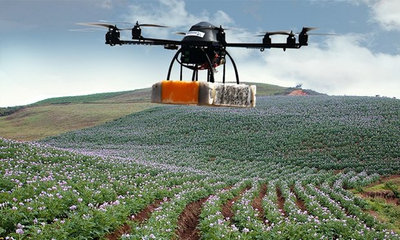
Some are killing machines. Others are pesky passions of the weekend hobbyist. As such, drones have not always been welcomed in our skies.
Across Africa, however, projects are being launched that could revolutionise medical supply chains and commercial deliveries, combat poaching and provide other solutions for an overburdened, underdeveloped continent.
In Rwanda, as in many other African countries, the rainy season makes already difficult roads between smaller towns and villages all but impassable. Battered trucks struggle through the mud, and in some cases even more agile motorbikes and foot traffic are unable get through.
“Rwanda is essentially a rural country. Lots of blood products cannot be stocked at every health centre. At best it can take four to six hours to get supplies through,” says the technology minister, Jean Philbert Nsengimana.
“For mothers giving birth, postpartum haemorrhaging, or bleeding post-delivery, happens quite often. It may not be possible to prevent. Then what is needed is a quick and rapid intervention.”
Enter Zipline, a California-based robotics company which has designed a fixed-wing drone to deliver medical essentials to rural health facilities. The “zip” – with a two-metre wingspan – releases a small, parachute-equipped payload that drifts down into a dropzone without the zip having to land.
“This technology has the potential to erase barriers to access for countless critical medicines and save lives on a scale not previously possible,” says Keller Rinaudo, Zipline’s chief executive, which is staffed by experienced aerospace engineers including those who have worked at SpaceX, Boeing and Nasa.
“While there are a number of potential applications for this technology, we’re keenly focused on using it to save lives.”
In its first phase, Zipline plans to make 50 to 150 deliveries of blood a day to 21 transfusing facilities within a 47-mile (75km) radius, later adding vaccines and other urgent supplies. Each zip, operating from bases called nests housing 15 autonomous devices, can fly a 75-mile round-trip on a single battery charge, including in wind and rain.
It is still early days – daily medical flights are scheduled to begin in late August or early September after safety testing is complete – but if Zipline succeeds in its goals, it will place Rwanda far ahead of many of the world’s richest economies in terms of its vision of a drone delivery network.
“For these drones to operate and share the airspace with normal aircraft, a lot of work has gone into legislation and airspace management – there are no precedents, we are creating something from scratch,” says Nsengimana.
“Most countries have legislation for drones that remain visible. But for fixed-wing drones that go beyond the line of sight, we found no regulation.”
Rwanda is the first government to sign a contract with the Silicon Valley startup to provide nationwide delivery services – the jury is still out as to how this will play out at a national scale, in conjunction with health providers and over longer distances.
The cost implications remain slightly unclear, although at Zipline’s Kigali launch on the sidelines of the World Economic Forum on Africa, Rwanda’s health minister, Dr Agnes Binagwaho, insisted that they were comparable to current delivery methods.
And Zipline, a for-profit entity, hopes other countries will follow in Rwanda’s footsteps. The global vaccine alliance Gavi and UPS Foundation – both Zipline backers – echo this optimism, as do several large tech donors that have funded the company.
Rwanda seems like a preferred spot to test drone models – a small country but with challenging terrain, often referred as the “land of a thousand hills”, and a government that prioritises innovation and efficiency.
This landlocked state is also poised to be the location of the world’s first droneport, designed by the award-winning British architect Norman Foster as one of a group of partners behind the Redline concept.
“We expect it to be finished by next summer – it’s really experimental and will be used by different cargo drone manufacturers,” says Jonathan Ledgard, founder of Redline and a former Africa correspondent for the Economist. “Aerospace companies are looking to move down in size, while robotics startups are looking to move up in size.”
The team believes Africa is growing too fast to build out its road network, and that high-intensity use of the lower sky is inevitable.
“We aim to have up to 18 ports on the national network for Rwanda, but there are much bigger opportunities in bigger countries, including beyond Africa,” says Ledgard, who in discussions with Airbus as well as other aerospace firms.
“We’re talking about a supplementary transport system – not replacing rail, lorries, bikes, adding another system that doesn’t exist but that does make sense.”
The concept envisages a Redline network, which transports medical and emergency supplies, and a Blueline network, which would make larger commercial deliveries and subsidise the medical supply chain.
“The droneport project is about doing ‘more with less’, capitalising on the recent advancements in drone technology – something that is usually associated with war and hostilities – to make an immediate life-saving impact in Africa,” says Foster, of the $70,000 (£53,000) low-tech, steel-free structure that was previewed at the Venice Biennale in May 2016.
“This is combined with a building system using local earth mixed with additives to create vaults. This enables local communities to create their own structures with a high level of sustainability.”
Read more: The Guardian From killin g machines to agents of hope: the future of drones in Africa
Photo Credit: A drone equipped with a camera hovers over potato crops in Peru. Photograph: International Potato Center via The Guardian

